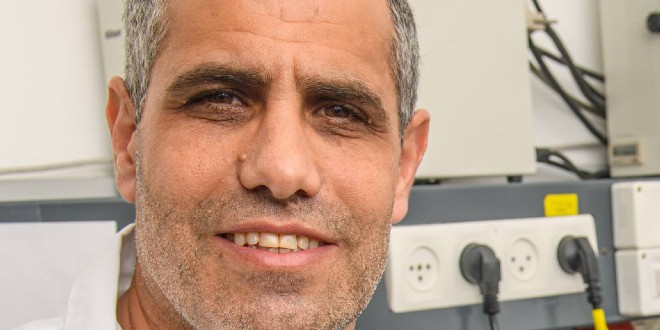ISRAELI SCIENTIFIC BREAKTHROUGH MAY MAKE IT POSSIBLE FOR PEOPLE WITH PARALYSIS TO WALK AGAIN
BY JUDY SIEGEL-ITZKOVICH | FEB 7, 2022 | MEDICAL/SCIENCE

Prof. Tal Dvir Credit Israel Hadari
Share this article
In the 34 developed countries, an estimated one percent of the population – or 10,000,000 people – require a wheelchair; in 156 developing countries, at least two percent – or 121,800,000 people –need a wheelchair. Overall, of the 7,091,500,000 people in the world, about 131,800,000 or 1.85% suffer from paralysis or weakness that requires a wheelchair to get around.
But one day, thanks to a major Israeli scientific breakthrough reached for the first time in the world, people with paralysis of their legs may be able to walk again. Researchers at the Sagol Center for Regenerative Biotechnology of Tel Aviv University (TAU) engineered functional human spinal cord tissues from human materials and cells and implanted them in lab models that featured chronic paralysis, successfully restoring walking abilities in 80 percent.
The technology behind the Israeli breakthrough uses patient tissue samples, transforming it into a functioning spinal cord implant via a process that mimics the development of the spinal cord in human embryos. “Our goal for the next few years is to engineer personalized spinal cord implants to repair tissue damaged from injury without the risk of implant rejection,” said the researchers.
The research was led by biotechnology Prof. Tal Dvir and included doctoral student Lior Wertheim, Dr. Reuven Edri, and Dr. Yona Goldshmit. Other contributors included Prof. Irit Gat-Viks from the Shmunis School of Biomedicine and Cancer Research, Prof. Yaniv Assaf from the Sagol School of Neuroscience, and Dr. Angela Ruban from the Steyer School of Health Professions – all at Tel Aviv University. The results of the study were published in the prestigious scientific journal Advanced Science under the title “Regenerating the injured spinal cord at the chronic phase by engineered iPSCs-derived 3D neuronal networks.”
The results were highly encouraging: an approximately 80% success rate in restoring walking abilities in the rodents. Now the researchers are preparing for the next stage of the study – clinical trials in human patients. They hope that within a few years the engineered tissues will be implanted in paralyzed individuals, enabling them to stand up and walk again.
“Our technology is based on taking a small biopsy of belly fat tissue from the patient,” explained Dvir. “This tissue, like all tissues in our body, consists of cells together with an extracellular matrix (comprising substances like collagens and sugars). After separating the cells from the extracellular matrix we used genetic engineering to reprogram the cells, reverting them to a state that resembles embryonic stem cells – namely cells capable of becoming any type of cell in the body.”
From the extracellular matrix, the team produced a personalized hydrogel that would evoke no immune response or rejection after implantation. They then encapsulated the stem cells in the hydrogel and in a process that mimics the embryonic development of the spinal cord and turned the cells into 3D implants of neuronal networks containing motor neurons.
The human spinal cord implants were then implanted in lab models, divided into two groups – those who had only recently been paralyzed (the acute model) and those who had been paralyzed for a long time – equivalent to a year in human terms (the chronic model). Following the implantation, 100% of the lab models with acute paralysis and 80% of those with chronic paralysis regained their ability to walk.
“The model animals underwent a rapid rehabilitation process, at the end of which they could walk quite well. This is the first instance in the world in which implanted engineered human tissues have generated recovery in an animal model for long-term chronic paralysis – which is the most relevant model for paralysis treatments in humans,” noted Dvir.
“There are millions of people around the world who are paralyzed due to spinal injury, and there is still no effective treatment for their condition. Individuals injured at a very young age are destined to sit in a wheelchair for the rest of their lives, bearing all the social, financial, and health-related costs of paralysis. Our goal is to produce personalized spinal cord implants for every paralyzed person, enabling regeneration of the damaged tissue with no risk of rejection. “
Based on the revolutionary organ engineering technology developed at his lab, Dvir teamed up with industry partners to establish Matricelf (www.matricelf.com) in 2019. The company applies his approach in the aims of making spinal cord implant treatments commercially available for persons suffering from paralysis. A first Phase 1 human trial is scheduled for 2024.
In 2019, Matricelf licensed the technology that enabled printing the first functioning 3D human heart from cells and matrix derived from a human omentum (layers of peritoneum that surround abdominal organs) biopsy from TAU.
Dvir said that the approach was tested for regeneration of the injured spinal cord, “but this platform can be used to treat many different diseases and injuries, such as Parkinson’s disease, brain
trauma, myocardial infarction, age-related macular degeneration – all of which are being investigated in our lab – and more.”
The TAU scientists concluded that “we hope to reach the stage of clinical trials in humans within the next few years, and ultimately get these patients back on their feet. The company’s preclinical program has already been discussed with the US Food and Drug Administration [FDA]. Since we are proposing an advanced technology in regenerative medicine, and since at present there is no alternative for paralyzed patients, we have good reason to expect relatively rapid approval of our technology.”
